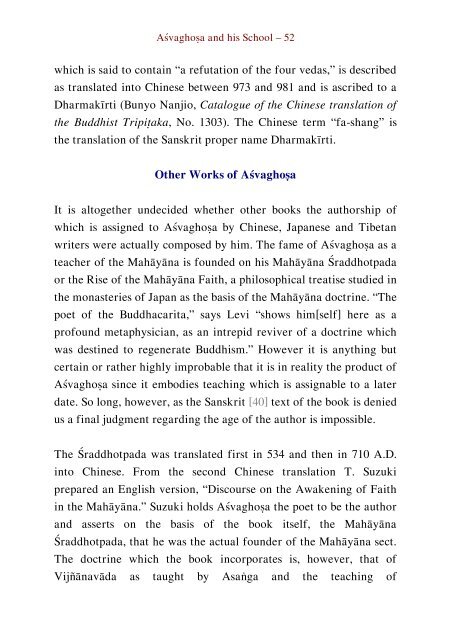Literary History of Sanskrit Buddhism
A study by J. K. Nariman of Sanskrit Buddhism from the Early Buddhist Tradition up to the Mahayana texts proper.
A study by J. K. Nariman of Sanskrit Buddhism from the Early Buddhist Tradition up to the Mahayana texts proper.
You also want an ePaper? Increase the reach of your titles
YUMPU automatically turns print PDFs into web optimized ePapers that Google loves.
Aśvaghoṣa and his School – 52<br />
which is said to contain “a refutation <strong>of</strong> the four vedas,” is described<br />
as translated into Chinese between 973 and 981 and is ascribed to a<br />
Dharmakīrti (Bunyo Nanjio, Catalogue <strong>of</strong> the Chinese translation <strong>of</strong><br />
the Buddhist Tripiṭaka, No. 1303). The Chinese term “fa-shang” is<br />
the translation <strong>of</strong> the <strong>Sanskrit</strong> proper name Dharmakīrti.<br />
Other Works <strong>of</strong> Aśvaghoṣa<br />
It is altogether undecided whether other books the authorship <strong>of</strong><br />
which is assigned to Aśvaghoṣa by Chinese, Japanese and Tibetan<br />
writers were actually composed by him. The fame <strong>of</strong> Aśvaghoṣa as a<br />
teacher <strong>of</strong> the Mahāyāna is founded on his Mahāyāna Śraddhotpada<br />
or the Rise <strong>of</strong> the Mahāyāna Faith, a philosophical treatise studied in<br />
the monasteries <strong>of</strong> Japan as the basis <strong>of</strong> the Mahāyāna doctrine. “The<br />
poet <strong>of</strong> the Buddhacarita,” says Levi “shows him[self] here as a<br />
pr<strong>of</strong>ound metaphysician, as an intrepid reviver <strong>of</strong> a doctrine which<br />
was destined to regenerate <strong>Buddhism</strong>.” However it is anything but<br />
certain or rather highly improbable that it is in reality the product <strong>of</strong><br />
Aśvaghoṣa since it embodies teaching which is assignable to a later<br />
date. So long, however, as the <strong>Sanskrit</strong> [40] text <strong>of</strong> the book is denied<br />
us a final judgment regarding the age <strong>of</strong> the author is impossible.<br />
The Śraddhotpada was translated first in 534 and then in 710 A.D.<br />
into Chinese. From the second Chinese translation T. Suzuki<br />
prepared an English version, “Discourse on the Awakening <strong>of</strong> Faith<br />
in the Mahāyāna.” Suzuki holds Aśvaghoṣa the poet to be the author<br />
and asserts on the basis <strong>of</strong> the book itself, the Mahāyāna<br />
Śraddhotpada, that he was the actual founder <strong>of</strong> the Mahāyāna sect.<br />
The doctrine which the book incorporates is, however, that <strong>of</strong><br />
Vijñānavāda as taught by Asaṅga and the teaching <strong>of</strong>


















